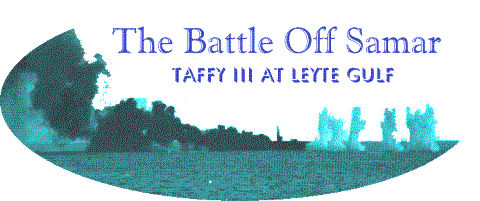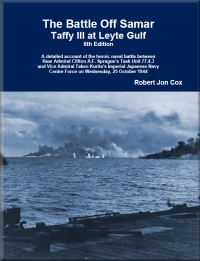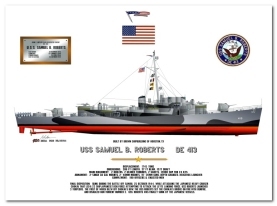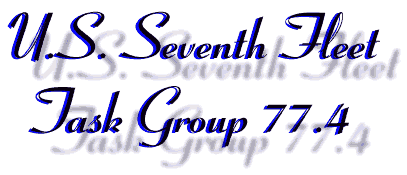
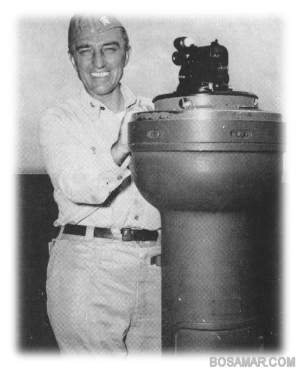
U.S. Navy Photograph
"Escort Carrier Group Commander"
October 25, 1944
Rear Admiral
Thomas L. Sprague
U.S. Navy
U.S. Naval Academy Class of 1917
Commander Task Group 77.4
Commander Task Unit 77.4.1
Commander Carrier Division 22
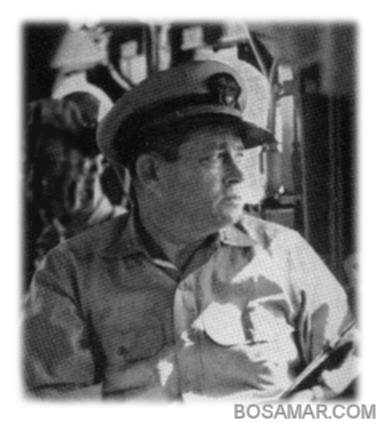
U.S. Navy photograph
"Victor at Samar"
October 25, 1944
Rear Admiral
Clifton Albert Frederick "Ziggy" Sprague
U.S. Navy
U.S. Naval Academy Class of 1917
Commander Task Unit 77.4.3 (Taffy III)
Commander Carrier Division 25
"At 0706, the enemy was closing with disconcerting rapidity, and volume and accuracy of fire was increasing. At this point, it did not appear that any of our ships could survive another five minutes of the heavy calibre fire being received, and some counteraction was urgently and immediately required. The Task Unit was surrounded by the ultimate of desperate circumstances. All escorts were ordered to attack the enemy with torpedoes. At this time, direct view of the enemy was obscured by smoke and results of our escorts attack could not be ascertained, but it is believed that, regardless of hits, they succeeded in turning the battleships away at least momentarily, and created a diversion of immense value."
COMCARDIV 25 Action Report, RADM C.A.F. Sprague, USN
Escort Carriers and their mission at Leyte Gulf
No modern fleet would be complete without air power. Seventh Fleet s punch came from one of the lesser known vessels assigned to the fleet. They were the CVE's, or escort carriers. These were the smallest of the American carriers that became well known for their extensive use in the Atlantic ocean sinking German U-boats. In the Pacific Fleet, the escort carrier was used for other roles than those available to its big brothers, the large fleet carrier and light carrier. On any given day a CVE pilot might fly Combat Air Patrol, bring water to thirsty army troops, hunt submarines, bomb bridges, perform reconnaissance, or the ship itself, be used in an auxiliary role to ferry replacement aircraft to the larger fleet carriers. Such was the life of a CVE pilot, less than glamorous when compared to their brothers on the large fleet carriers.
The escort carrier's present at Leyte Gulf were headed by Rear Admiral Tommy Sprague, Commander Task Group 77.4. They consisted of eighteen baby flattops, separated into three equal six-ship Task Units, called "Taffies." At Leyte Gulf, the mission of the escort carriers was to provide direct air support for the landings and to put up Combat Air Patrols to protect the invasion fleet. The escort carriers at Leyte Gulf boasted 235 fighters and 143 torpedo planes. Each Taffy had a small screen of three destroyers and four or five destroyer escorts. Most of the men who manned the ships of Task Group 77.4 were reservists who had never seen any major action.
One draw back at Leyte was the lack of training received by the escort carrier pilots. Although the CVE s carried some armor-piercing bombs and torpedoes, they were not adequately stocked nor were their pilots adequately trained in warship-attack tactics.
Although the CVE's were designated as aircraft carriers," the term is misleading. They were hardly a match in comparison with the larger light and heavy carriers of the fleet. One-third the size of the heavy carriers, they were cramp, unarmored, thin-hulled vessels, unable to launch and recover aircraft with the ease of the larger carriers. Despite their many restrictions, the escort carriers pulled a heavy load at Leyte Gulf.
All three Taffies were stationed east of Leyte Gulf, on a north-south axis. Rear Admiral Tommy Sprague himself, commanded Task Unit 77.4.1 , known as Taffy I. His task unit operated ninety miles southeast of Suluan Island, near Mindanao. One-hundred miles to the north lay RADM Felix Stump's Task Unit 77.4.2, Taffy II. His group was parallel to the entrance of Leyte Gulf. The northern most group of escort carriers, Task Unit 77.4.3, Taffy III, belonged to RADM C.A.F. Sprague. Taffy III sailed thirty to sixty miles off the shore of Samar, the large island northeast of Leyte. The escort carriers of each Taffy were further organized into a two or four ship section, each commanded by another Rear Admiral.
The Composition of Task Group 77.4
| Task Unit 77.4.1 (Taffy I) |
| RADM Thomas L. Sprague, USN |
| *RADM George R. Henderson, USN |
| * = Detached 1645, October 24, 1944 |
| Task Unit 77.4.2 (Taffy II) |
| RADM Felix B. Stump, USN |
| RADM William D. Sample, USN |
| Task Unit 77.4.3 (Taffy III) |
| RADM Clifton A. F. Sprague, USN |
| RADM Ralph A. Ofstie, USN |
Composition of Task Unit 77.4.1
Task Unit 77.4.1 (Taffy I) RADM Thomas L. Sprague
Escort Carriers
COMCARDIV 22 RADM Thomas L. Sprague
USS SANGAMON (CVE 26) (Flagship) CAPT M.E. Browder
• Air Group 37 LCDR S.E. Hindman
• VF-37 16 F6F-3 & 5 F6F-5 LCDR S.E. Hindmman
• VT-37 9 TBM-1C LCDR P.G. Farley
USS SUWANEE (CVE 27) CAPT W.D. Johnson
• Air Group 60 LCDR H.O. Feilbach
• VF-60 22 F6F-3 LCDR H.O. Feilbach
• VT-60 9 TBM-1C LCDR W.C. Vincent
USS CHENANGO (CVE 28) CAPT G. van Deurs
• Air Group 35 LCDR F.T. Moore
• VF-35 22 F6F-3 LCDR F.T. Moore
• VT-35 9 TBM-1C LCDR C.F. Morgan
USS SANTEE (CVE 29) CAPT R.E. Blick
• Air Group 26 LCDR H.N. Funk
• VF-26 24 FM-2 LCDR H.N. Funk
• VT-26 6 TBF-1C & 3 TBM-1C LCDR T.M. Bennett
COMCARDIV 28 RADM George R. Henderson
USS SAGINAW BAY (CVE 82) (Flagship) CAPT F.C. Sutton
• VC-78 15 FM-2 & 12 TBM-1C LCDR J.L. Hyde Jr.
USS PETROF BAY (CVE 80) CAPT J.L. Kane
• VC-76 16 FM-2 & 12 TBM-1C CDR J.W. McCauley
Destroyers
Screen Commander - CAPT I.H. Nunn
USS MCCORD (DD 534) CDR F.D. Michael
USS TRATHEN (DD 530) CDR J.R. Millett
USS HAZELWOOD (DD 531) CDR V.P. Douw
Destroyer Escorts
USS EDMONDS (DE ) LCDR J.S. Burrows
USS RICHARD S. BULL (DE 402) LCDR A.W. Gardes
USS RICHARD M. ROWELL (DE 403) CDR H.A. Barnard
USS EVERSOLE (DE 404) LCDR G.E. Marix
USS COOLBAUGH (DE 217) LCDR S.T. Hotchkiss
Composition of Task Unit 77.4.2
Task Unit 77.4.2 (Taffy II) RADM Felix B. Stump
Escort Carriers
COMCARDIV 24 RADM Felix B. Stump
USS NATOMA BAY (CVE 62) (Flagship) CAPT A.K. Morehouse
• VC-81 16 FM-2 & 12 TBM-1C LCDR R.C. Barnes
USS MANILA BAY (CVE 61) CAPT Fitzhugh Lee
• VC-80 16 FM-2 & 12 TBM-1C LCDR H.K. Stubbs
COMCARDIV 27 RADM William D. Sample
USS MARCUS ISLAND (CVE 77) (Flagship) CAPT C.F. Greber
• VC-21 17 FM-2 & 12 TBM-1C LCDR T.O. Murray
USS KADASHAN BAY (CVE 76) CAPT R.N. Hunter
• VC-20 15 FM-2 & 11 TBM-1C LCDR J.R. Dale
USS SAVO ISLAND (CVE 78) CAPT C.E. Ekstrom
• VC-27 17 FM-2 & 12 TBM-1C LCDR P.W. Jackson
USS OMMANEY BAY (CVE 79) CAPT H.L. Young
• VC-75 16 FM-2 & 11 TBM-1C LT A.W. Smith Jr.
Destroyers
Screen Commander - CAPT L.K. Reynolds
USS FRANKS (DD 554) CDR D.R. Stephan
USS HAGGARD (DD 555) CDR D.A. Harris
USS HAILEY (DD 556) CDR P.H. Brady
Destroyer Escorts
USS RICHARD W. SUESENS (DE 342) LCDR R.W. Graham
USS AMBERCROMBIE (DE 343) LCDR B.H. Katschinski
USS OBERRENDER (DE 344) LCDR S. Spencer
USS WALTER C. WANN (DE 412) LCDR J.W. Stedman
USS LE RAY WILSON (DE 414) LCDR M.V. Carson
Composition of Task Unit 77.4.3
Task Unit 77.4.3 (Taffy III) RADM Clifton A.F. Sprague
Escort Carriers
COMCARDIV 25 RADM Clifton A.F. Sprague
USS FANSHAW BAY (CVE 70) (Flagship) CAPT Douglass P. Johnson
• VC-68 16 FM-2 & 12 TBM-1C LCDR R.S. Rogers
USS SAINT LO (CVE 63) CAPT Francis J. McKenna
• VC-65 17 FM-2 & 12 TBM-1C LCDR R.M. Jones
USS WHITE PLAINS (CVE 66) CAPT Dennis J. Sullivan
• VC-4 16 FM-2 & 12 TBM-1C LT E.R. Fickenscher
USS KALININ BAY (CVE 68) CAPT Thomas B. Williamson
• VC-3 14 FM-2, 1 TBF-1C & 11 TBM-1C LCDR W.H. Keighley
COMCARDIV 26 RADM Ralph A. Ofstie
USS KITKUN BAY (CVE 71) (Flagship) CAPT John P. Whitney
• VC-5 14 FM-2 & 12 TBM-1C CDR Robert L. Fowler
USS GAMBIER BAY (CVE 73) CAPT Walter V.R. Vieweg
• VC-10 18 FM-2 & 12 TBM-1C LCDR Edward J. Huxtable
Destroyers
Screen Commander - CDR William D. Thomas
USS HEERMANN (DD 532) CDR Amos T. Hathaway
USS HOEL (DD 533) CDR Leon S. Kintberger
USS JOHNSTON (DD 557) CDR Ernest E. Evans
Destroyer Escorts
USS JOHN C. BUTLER (DE 339) LCDR John E. Pace
USS RAYMOND (DE 341) LCDR Aaron F. Beyer, Jr.
USS DENNIS (DE 405) LCDR Sigurd Hansen
USS SAMUEL B. ROBERTS (DE 413) LCDR Robert W. Copeland
